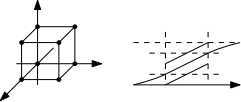标签:ali problem wing one nat poi text enc infinite
I got to know the following problem yesterday given by professor Feder Patrov.
Let $\mu$ be a probability over $X$ (i.e. a measure with $\mu(X)=1$). If $\mu$ is non-atomic, then for any $C\in [0,1]$, there exists $Y\subseteq X$ such that $\mu(Y)=C$.
Where a measure is said to be non-atomic if every measurable $E$ such that $\mu(E)>0$ contains a measurable subset $A$ such that $0< \mu(A)< \mu(E)$.
The intuition is to approximate the number. But after a peroid of attemption, it turns to be not that easy to ensure the approximation works. Actually, I read a proof from Rudin‘s textbook functional analysis Page 120.
We can define a functional $$\Lambda : L^\infty(\sigma)\longrightarrow \mathbb{R} \qquad g\longmapsto \int g\mathrm{d}\mu. $$ Consider the ``unit cube‘‘ of $L^\infty(\sigma)$, $$K=\{g\in L^\infty(\sigma): 0\leq g\leq 1\}$$ then $K$ is weak-$*$ compact (by Banach-Alaogu theorem) and convex (trivially). Hence $\Lambda(K)$ is a compact convex subset of $\mathbb{R}^n$.
We will prove that $\Lambda(K)$ is the desired range. The main idea is that the extreme points of a finite dimensional cube (resp. unit cube in $L^\infty(\sigma)$) is the $0,1$-tuple (resp. characteristic function).
For any $p\in \Lambda(K)$, denotes its inverse image by $K_g=\Lambda^{-1}(p)$. If $g_0\in K_p$ is not a characteristic function, then some measurable $E$ with $\sigma(E)>0$ and $r\leq g_0\leq 1-r$ on $E$. Since $\sigma$ is not atomic, $\chi_E \cdot L^\infty(\sigma)$, the space of functions living on $E$, is of infinite dimension, so some nonzero element gets killed by $\Lambda$, say $\Lambda g=0$. We can assume $-r<g<r$, then $g_0+g$ and $g_0-g$ are both in $K_p$, so $g_0$ turns not to be an extreme point. %In conclusion, $g_0$ is not extreme point. By Krein-Milman Theorem, there always exists extreme point.
The image is as follow.

There are some remarks on this proof.
It is equivalent to the following assertion
"Suppose $\mu_1,\ldots,\mu_n$ are non-atomic measures. Then the set consisting all
$$\bigg(\,\mu_1(E),\ldots ,\mu_n(E)\,\bigg)\in \mathbb{R}^n$$
is a compact convex subset of $\mathbb{R}^n$."
Because a subset of $\mathbb{R}^n$ is convex iff for any linear function $f$, the image under $f$ is convex. Or modify the above proof a little to get it.
After that, I considered whether there exists an elementary proof? Follow the intuition of approximation the number, the gap is that we cannot approximate it well. For example, $c=1/2$, you may find a series of measurable sets of measures $\frac{3}{4}+\frac{1}{4},\frac{3}{4}+\frac{1}{8},\frac{3}{4}+\frac{1}{16},\cdots$. They get close to $1/2$ but not approach $1/2$. Now you should choose the intersection of them to get a measurable set of measure $3/4$, and repeat such procedure, but it may be $\frac{5}{8}+\frac{1}{8},\frac{5}{8}+\frac{1}{16},\cdots$. If we want to make correct induction, we must use some tool in set theory.
We use ordinal number to prove the assertion. We will define a function $f$ from the first uncountable ordinal number $\aleph_1$ to the sigma-algebra of measurable sets $\mathfrak{M}$. Such that $\alpha\in \beta$ implies $f(\alpha)\subseteq f(\beta)$ or $f(\beta)\subseteq f(\alpha)$. %$0<\mu(f(\beta))-c<\mu(f(\alpha))-c$.
- define initially $f(\varnothing)=X$.
- assume that for $\alpha\in \mathbf{Ord}$, elements less than $\alpha$ is defined. Denote
$$U_{\alpha}=\bigcap\left\{f(\beta):\begin{array}{l}\mu(f(\beta))>c\\ \beta<\alpha\end{array}\right\}
\qquad L_{\alpha}=\bigcup\left\{f(\beta):\begin{array}{l}\mu(f(\beta))<c\\ \beta<\alpha\end{array}\right\}$$
Now $U_{\alpha}\setminus L_{\alpha}$ is measurable (only at most countable many) and also of measure nonzero (otherwise, the conclusion follows). So we can find some $A$ with the property with respect to $U_{\alpha}\setminus L_{\alpha}$, then we define $f(\alpha)=L_{\alpha}\cup A$.Such function exists by transfinite induction(which is equivalent to axiom of choice). But now we have uncountable many subsets with distinct measures, but $\mathbb{R}$ is so crowed to accept uncountable many nonintersetion open intevals
$$\{\textrm{real numbers between $\mu(f(\alpha))$ and $\mu(f(\alpha+1))$}\}$$
(This is a pure topology argument by picking one rational number in each interval).
Of course, this is a natural proof but not an elementary proof.
Non-atomic probability takes all values between $0$ and $1$
标签:ali problem wing one nat poi text enc infinite
原文地址:https://www.cnblogs.com/XiongRuiMath/p/11481785.html